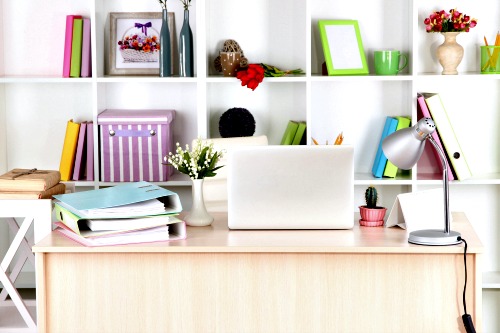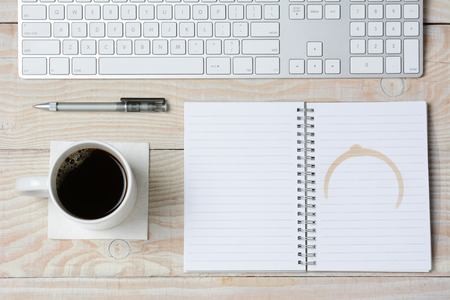- Clean Home
- Organize Your Home
- Home Office Organization Tips
Home Office Organization Tips
If you work from home, these home office organization tips can help set you up for efficiency. Let's face it: Everyone works at home.
Kids do homework. Parents pay bills, manage their finances, and juggle their schedules. And some people even run businesses from their homes.
Whether you use your home office daily for your job or just a few afternoons a week to pay bills online and send e-mails, you'll need the same essentials for an efficient but comfy space to get it all done.
Home Office Organization by the (Note)Book
Want your home work to run like clockwork? These home office organization tips can help:
I have one notebook for to-do lists and a second for everything else. These two notebooks keep me straight. The key is that I write everything in them rather than tiny pieces of information on small pieces of paper. Try it!
This way, no slips of paper are lost, no phone numbers are misplaced, and you don't have to tear up the house looking for the napkin with the contractor's name on it.
To find a message, you just have to think, "Hmmm. I talked to them sometime last September." Then, you flip back to the pages you wrote in September. Low-tech? You bet. Efficient? Absolutely. Home office organization at its best!
When you finish a notebook, place it in a box with the dates clearly labeled on the front. Keep it for reference. You'll need it.
Give Everything Its Own Space
Give everything its own space. Think drawers, trays, file holders, and bins. Keep things nearby - but not necessarily on - your desktop. Your goal, should you choose to accept it, is to keep 75 percent of your desktop visible at all times.
Make sure everything is at arm's length. Here's where the "near" comes in. You shouldn't have to get up to get your files, your fax, or your phone.
Store Things Used Together in the Same Place
Home office organization tips work best when you keep things simple. Keep stamps, a pen that actually writes, a calculator, and envelopes together so that bill time's a breeze (or at least as much of a breeze as bill time can be.)
Pens, pencils, and highlighters are among the assorted essentials that need a home spot in your home office. A cute mug with your kid's baseball picture works great; a drawer will do in a pinch.
Other home office organization tips include placing essentials in a single supplies drawer or box for easy grabbing. This includes items like staplers, tape, paper cutters, a hole punch, stamps, and thumbtacks.
The bottom line is to group them so you can grab them in a pinch. (While we're talking about office supplies, choose staples over paper clips. Clips get caught on other papers and come apart more easily. Just keep a staple remover handy.)
Save time searching through drawers by storing as many items as possible in clear containers.
Create a Place For Everything
If you're short on space, store supplies and less-used items in a closet or in another part of your home.
Throw out what you can. Ditch yesterday's news and last month's magazines. Okay, so you won't read a newspaper from three days ago; why on earth are you keeping months-old magazines around?
If you're saving a magazine for a reason - an article you want to clip out, say - clip it out and recycle the rest. Forget about using those old rags as a "reference."
Chances are, if the time rolls around when you need it, you'll forget that the items are there. Instead, clip items you'd like to keep immediately, and you'll have room for all the new mags that arrive daily in your mailbox.
Be Prepared for Disaster
If you're prepared for disaster, then it won't happen, of course. But if it does, you'll be prepared. Regularly back up critical computer files on a thumb drive or other safe format.
Purchase - and use - a power surge protector for your computer and all your electronic items.
Home Office Organization Tips for Small Spaces
When space is at a premium, your organization must be, too. If you've got a cramped office, it's time to get creative and think outside the box.
Maximize floor space by not putting your desk in the traditional place, up against the wall.
Instead, consider putting it in the middle of the room or perpendicular to the wall. However, do have it facing the door so you can greet visitors without a jump.
To make the most of your limited wall space, get one tall file holder instead of a couple of two-drawer models. Use extra wall space for shelves.
I started with file drawers in my home office a few years ago. That idea lasted about a day.
Once I began filing my myriad papers, I realized quickly that leaving the walls out of the storage and organizing routine wouldn't cut it.
I chose cabinets with shelves, mostly so I could use the space to tuck away the more unruly stuff: odd-size books, papers, miscellany from my father's estate, a box of printed envelopes for work correspondence, etc.
But to soften my bedroom's office feel, I confined some of the clunkier items in wicker baskets and even a hatbox. Whatever I have around that's big enough to hold things inside is fair game for home office organization in my home.
You may want a wall of deep shelving for things like boxes of printer paper. I use my covered shelving to store those items, too. But in a pinch, you can retrieve these items from the basement or garage when needed.
So stash the overflow in a nearby closet (or even one that's not so close). Just don't seriously attempt to get any work done when you have to dodge file shelves and step over stationery supplies to get to your seat or sort through a mishmash of mail, bills, and letters from school and the softball team on your obscured desktop.
However, if you need more drawer space, at least one item that might be worth maneuvering around in your home office: an inexpensive rolling cart that you can stash under your desk.
Ditto for your files: If you're running out of options, a rolling cart for your files can be stashed out of sight in your closet when company comes, then rolled out to the home office when you're ready to conquer the world. This is home office organization at its finest!
- Clean Home
- Organize Your Home
- Home Office Organization Tips




















